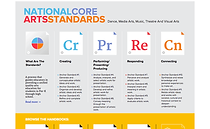1a. Demonstrating Knowledge of Content and Pedagogy
1a. Demonstrating Knowledge of Content and Pedagogy

Planning & Preparation
1a. Demonstrating Knowledge of Content and Pedagogy
FRAMEWORKS & STANDARDS
TEXTBOOKS






OTHER GENERAL RESOURCES






The standards, frameworks, textbooks, and general resources above are a highlighted selection of the numerous materials that I use to inform my teaching; whether it be my planning, my instructing, my assessing, or my relationship building. The use of these materials has helped me deepen my understanding and knowledge of my content area, my pedagogic approach, my teaching, and my students. The use of these materials when planning my lessons and units has helped me anticipate and address my students' needs. My resource library is continuously growing, and I am dedicated to search for the best resources to better my teaching for my students.
1b. Demonstrating Knowledge of Students
The documents highlighted above, represent a selection of the types of activities, assignments, and other general documents that I have created in the past, in order to deepen my knowledge of the students I teach, their progress, and their needs. Learning about my students, their background, their experiences, and their learning patterns, is the first thing I do in the school year. I believe in establishing a classroom culture that is specific to the students in each class. Learning about my students' prior knowledge on specific content is also the first thing I do every time I introduce new content, in order to gear my lessons and activities to students' particular needs.
1c. Setting Instructional Outcomes
The lesson plans presented here show the lengthy thought process I go through when planning every lesson; establishing the resources that helped me develop each lesson, how I will address student centered learning, as well as a clear structure with smooth transitions. When planning each and every lesson, I consider: the state and national standards, the developmental qualities of each age group, common misconceptions surrounding the content, prior learning and background of my students, which modifications and differentiations may be needed, as well as what activities and assessments will guide students to success. Additionally, organization and a clear progression of the material, is something I consider vital for student success.
1e. Designing Coherent Instruction
The teaching materials presented above, showcase both activities and supports I have used in order to help students understand content better, and follow along with the lesson more efficiently. These teaching materials combine the planning that takes place whenever I teach a lesson, with the pedagogical knowledge I have on how to better prepare students for success in each lesson. I use a variety of tools to help my students of different backgrounds and different needs all follow along with my teaching. As stated in my educational philosophy, I know the importance of all students learning dance, and I use supports such as those shown above to achieve this goal.
1f. Designing Student Assessments




These documents represent assessments, assessment materials, as well as data collected from assessments. Within my units I include a combination of self-assessment, peer assessment, and teacher assessment. I also combine diagnostic assessment, formative assessment, and summative assessment as tools for student growth and development. I do not consider assessments as the end goal in instruction and learning. I utilize assessments as a means to further develop my understanding of my students, and as tools to better my instruction in the future. I collect data from my assessments for this purpose. I believe that assessments are simply yet another chance for students to deepen their understanding of content.
Or select the domain number you would like to visit next.








